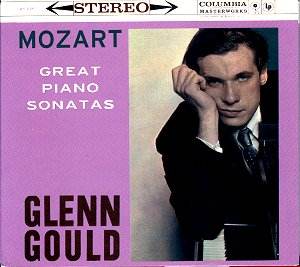Released as part of the Glenn Gould Anniversary Edition
the Mozart sonatas seem so long ago to have entered the continuum of
Gould’s eccentricity that it’s a little surprising to realise that the
most recent, K457, only dates from 1974. As a reflection of the solecisms
– frequently extreme even by Gouldian standards – inflicted on Mozart
Michael Stegemann has concocted a very Gouldian and fictive Colloquium
Olympium in which the shades of pianist and composer meet to discuss
Gould’s playing. Whimsical though this sounds – and occasionally is
– it has two merits; one of paying not so oblique homage to Gould’s
own literary self-interviewing and secondly to collate material relevant
to an analysis of his approach to Mozart. Some of this seems to derive
from conversations Gould had with Bruno Monsaingeon and others. Even
though such moments as the opening movement of the A Major, K331, have
long since entered the annals of perversity it’s by no means an arid
occupation to consider why and how Gould subjected Mozart to such a
degree of inversion, debunking and finally rejection.
The A Minor, K310, opens exceptionally quickly with
a gabbling insistence, a powerful, absurdly proto-Brahmsian declamatory
force applied to it. The slow movement is better but still superficial
in the extreme and the Presto finale again rather bad temperedly swift.
In the first of the two C Majors, K330, his mezzo forte playing, undifferentiated
dynamics, and frankly robotic mechanisms – part of an avowedly anti-theatrical
ploy when it came to Mozart, whose early works he liked and later works,
by and large, he despised. As a result the peaks and troughs of the
Andante cantabile are remorselessly elided, Gould passing over and through
with seemingly contented indifference. As for K331, a locus classicus
of Gouldian perversity, he apparently believed, or brought himself to
believe, that each variation in the opening movement should be faster
than the preceding one, culminating in Variation Five, marked Adagio
and played by Gould as an Allegro. To be fair he admitted his idiosyncrasies
and averred that he was subjecting Mozart to Webern like scrutiny –
at other times freely admitting to friends that he didn’t much like
Mozart and was simply having fun. Everything about this sonata recording
is absurd – the minuet and trio is interminable and the finale is taken
at a ridiculously slow tempo with a lack of synchronicity between the
hands and a feeling of cynical indifference.
K457 had a protracted recording history; Gould began
to record it on 5 November 1973 but returned to the studios twice in
June the following year and again in September before it was successfully
completed. The opening Allegro goes quite well but the Adagio still
features his détaché phrasing, his non-legato, unvaried
series of dynamics and anti-melodic determinism and lasting twelve minutes
is endless. The concluding finale is an exercise in deconstruction and
utterly disjunct. The final of the sonatas here, K545, is slightly better
but in the cold light of day still lifeless and depressing, despite
all Gould’s digital flexibility. One for Completists or anti-Mozartians.
Jonathan Woolf


